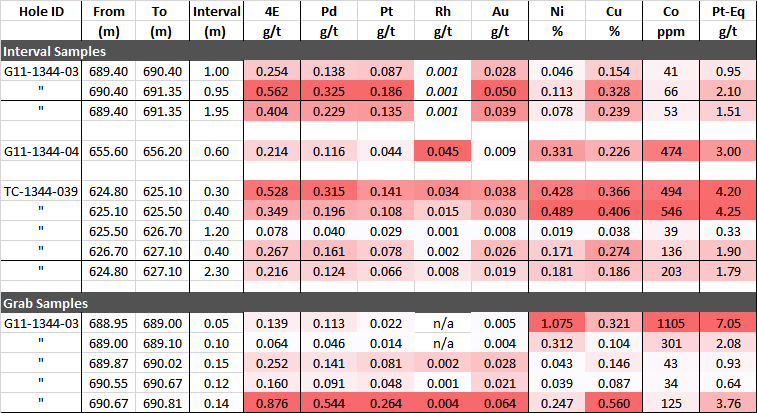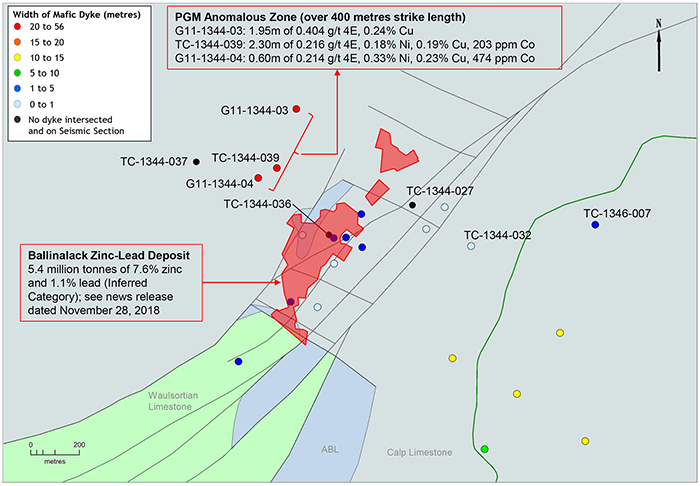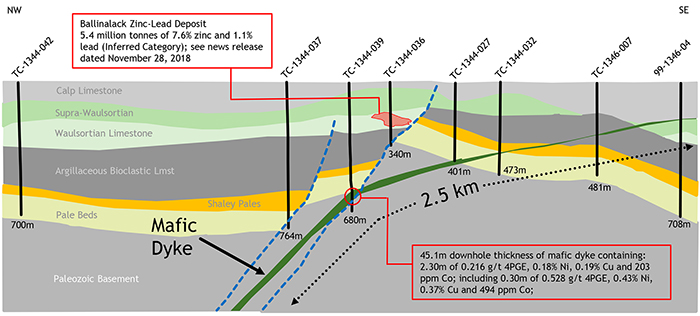Group Eleven Identifies Anomalous Palladium, Nickel and Cobalt at Ballinalack Zinc Project, Ireland
Vancouver, Canada, January 14, 2020 – Group Eleven Resources Corp. (TSX.V: ZNG; OTC: GRLVF; FRA: 3GE) (“Group Eleven” or the “Company”) is pleased to announce that recent drilling at its 60%-interest Ballinalack Zinc Project (“Ballinalack”) in the Republic of Ireland, has intersected a sulphide-bearing mafic dyke with anomalous platinum-group metals (“PGMs”, including platinum, palladium, rhodium) and gold, along with highly anomalous copper, nickel and cobalt. The dyke appears to laterally extend over several kilometres. Previous operators at Ballinalack did not assay for PGMs and to management’s knowledge, PGM exploration in the Republic of Ireland has never been conducted. Group Eleven views the above results as a potential ‘sweetener’ to Ballinalack, which remains primarily a zinc-focussed project. Zinc-lead results from the recently completed Ballinalack drill program are expected over the next few weeks.
Highlights:
- G11-1344-03 intersected 1.95 meters of 0.403 g/t 4E (platinum, palladium, rhodium and gold) and 0.24% copper, including 0.95 metres of 0.561 g/t 4E, 0.33% copper and 0.11% nickel;
- From the above, a grab-sample isolating sulphide-rich core (over 14 cm) returned 0.872 g/t 4E, 0.56% copper and 0.25% nickel;
- Another grab-sample of sulphide-rich core (over 5 cm) returned 1.08% nickel, 0.32% copper, 1105 ppm cobalt and 0.139 g/t 4E;
- G11-1344-04 intersected 0.60 metres of 0.33% nickel, 0.23% copper, 474 ppm cobalt and 0.214 g/t 4E;
- Re-sampling historic hole TC-1344-039 returned 2.30 metres of 0.216 g/t 4E, 0.19% copper, 0.18% nickel, 203 ppm cobalt, including 0.30 metres of 0.528 g/t 4E, 0.43% nickel, 0.37% copper and 494 ppm cobalt;
- Above three holes pierce the dyke over a strike-length of over 400 metres near the Ballinalack zinc deposit1; dyke appears to extend over at least 3 km by 7 km, based on drilling and seismic data;
- Group Eleven suspects the above intercepts may represent ‘rip-up’ clasts from a larger sulphide body, which may be a key exploration target in the future;
“The above results were unexpected and a bit out of left field, given our exploration efforts were fully geared towards zinc,” stated Bart Jaworski, CEO. “Despite being a surprise, these anomalous PGM results certainly add to the Ballinalack story. We intend to do more work on PGMs in the future as we remain focussed on exploring for zinc and expanding the existing Ballinalack zinc deposit1.”
Details on Mafic Dyke
Group Eleven drilled two diamond drill holes (G11-1344-03 and G11-1344-04) beneath the existing Ballinalack zinc-lead deposit. In addition to testing the Pale Beds for zinc mineralization (to be reported in the next few weeks), the holes intersected a mafic dyke with down-hole thicknesses (true widths unknown) of 29 metres and 56 metres, respectively. The latter intercept represents the thickest known dyke intercept on the property. Sulphide mineralization was observed at the base of the dyke, which in turn led Group Eleven staff to analyse for PGMs a nearby historic hole (TC-1344-039, drilled by Teck Resources Ltd. in 2010) which also exhibited similar material. Key information is summarized below:
- Assay results from new Group Eleven drilling and new PGM assays from historic hole (TC-1344-039) are summarized in Exhibit 1;
- The dyke appears to be laterally extensive over several kilometres; the thickest portions (greater than 10-metre down-hole thickness) of the mafic dyke appear to occur over an area of over 3.0 km by 7.0 km, based on recent and historic drilling, as well as, seismic data (see Exhibit 2);
- The above three holes pierce the dyke over a strike-length of over 400 metres (see Exhibit 3);
- The dyke has been intersected at shallow depths on the eastern part of the property and at deeper levels towards the west (see Exhibit 4); depths of the mafic dyke within the above three holes is approximately 650-700 metres below surface;
- Group Eleven has not yet been able to analyse historic drill logs and drill core to determine if, and to what extent, previously intersected mafic dyke material contained sulphides (historic drilling was focussed solely on zinc exploration and descriptions of the mafic dyke may have been very cursory in nature);
- Based on the textures of the sulphides, Group Eleven suspects the above intercepts may represent ‘rip-up’ clasts from a larger sulphide body, which may be a key exploration target in the future;
Exhibit 1. Highlights of New Assays from Mafic Dyke near the Ballinalack Zinc-Lead Deposit, Ireland

Notes: Rh assays from G11-1344-03 (italicized) were assumed to be half the detection limit; true width is unknown at this time; Platinum-equivalent (“Pt-Eq”) grade compiles the above metal grades into a single number and is calculated from metal prices (US$) as follows: $1650/oz Pd, $900/oz Pt, $4500/oz Rh, $1400/oz Au, $6.00/lb Ni, $2.60/lb Cu and $15.00/lb Co.
Exhibit 2. Plan Map Showing New Drilling and Extent of Thickest (>10 metres) Portion of Mafic Dyke

Exhibit 3. Drill Hole Plan Map Showing Three Key Holes Intersecting Mafic Dyke Over 400m Strike Length

Exhibit 4. Cross-Section Showing Interpretation of Mafic Dyke (from Seismic Data and Historic Drilling)

Update on Zinc Exploration Drilling
All drilling at Ballinalack as part of the current exploration phase announced on August 6th, 2019 has now been completed. Zinc-focussed assays and interpretation are nearing completion. Group Eleven aims to provide a full update on these results over the next few weeks.
About the Ballinalack Project
The Ballinalack project is a joint venture between Group Eleven (60% interest) and Shenzhen Zhongjin Lingnan Nonfemet Company Limited (40% interest), one of the largest zinc producers in China, and is located in Counties Westmeath and Longford, north-east Ireland. The property contains what is believed by the Company to be the third largest undeveloped zinc-lead occurrence in Ireland and is located approximately 50 kilometres west from the currently producing Navan Zinc-Lead Mine (Boliden AB).
Qualified Person
Technical information in this news release has been approved by David Furlong, P.Geo., Chief Operating Officer, and ‘Qualified Person’ as defined under Canadian National Instrument 43-101.
About Group Eleven Resources
Group Eleven Resources Corp. (TSX.V: ZNG; OTC: GRLVF and FRA: 3GE) is a mineral exploration company focused on advanced stage zinc exploration in Ireland. The Company’s large land package allows Group Eleven to leverage new geological approach and geophysical technology to systematically rethink key aspects of the Irish zinc district. The Company’s two key projects in Ireland include: a 60% interest in the Ballinalack project (joint ventured with Nonfemet - one of the largest zinc producers in China), located in north-east Ireland, hosting potential Navan Bed mineralization in the Pale Beds; and a 76.56% interest in the Stonepark project (joint ventured with Arkle Resources plc), located near Limerick, next to one of the world’s largest undeveloped zinc deposits: Pallas Green deposit. The Company’s team includes accomplished mining professionals with direct experience in finding mines, building companies and exploring Irish zinc deposits.
Additional information about the Company is available at www.groupelevenresources.com.
ON BEHALF OF THE BOARD OF DIRECTORS
Bart Jaworski, P.Geo.
Chief Executive Officer
For more information, please contact:
Spiros Cacos, MA
Vice President, Investor Relations
E: s.cacos@groupelevenresources.com | T: +1 604 630 8839
Cautionary Note Regarding Forward-Looking Information
This press release contains forward-looking statements within the meaning of applicable securities legislation. Such statements include, without limitation, statements regarding the future results of operations, performance and achievements of the Company, including the timing, content, cost and results of proposed work programs, the discovery and delineation of mineral deposits/resources/ reserves and geological interpretations. Although the Company believes that such statements are reasonable, it can give no assurance that such expectations will prove to be correct. Forward-looking statements are typically identified by words such as: believe, expect, anticipate, intend, estimate, postulate and similar expressions, or are those, which, by their nature, refer to future events. The Company cautions investors that any forward-looking statements by the Company are not guarantees of future results or performance, and that actual results may differ materially from those in forward looking statements as a result of various factors, including, but not limited to, variations in the nature, quality and quantity of any mineral deposits that may be located. All of the Company's public disclosure filings may be accessed via www.sedar.com and readers are urged to review these materials, including the technical reports filed with respect to the Company's mineral properties.
1 Ballinalack Mineral Resource Estimate (MRE) totals 5.4 million tonnes of 7.6% zinc and 1.1% lead (see news release dated November 28, 2018)

